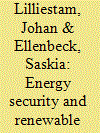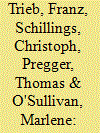| Srl | Item |
| 1 |
ID:
105756


|
|
|
|
|
| Publication |
2011.
|
| Summary/Abstract |
Solar power imports to Europe from the deserts of North Africa, as foreseen in the Desertec concept, is one possible way to help decarbonising the European power sector by 2050. However, this approach raises questions of threats to European energy security in such an import scenario, particularly in the light of increasing import dependency and Russia's use of the "energy weapon" in recent years. In this paper we investigate the threat of North African countries using the Desertec electricity exports as an "energy weapon". We develop and use a new model to assess the interdependence - the bargaining power symmetry, operationalised as costs - of a disruption in a future renewable electricity trade between North Africa and Europe. If Europe maintains current capacity buffers, some demand-response capability and does not import much more than what is described in the Desertec scenario, it is susceptible to extortion and political pressure only if all five exporter countries unite in using the energy weapon. Europe is not vulnerable to extortion by an export cut from only one country, as the European capacity buffers are sufficient to restore the power supply: no single exporter country would have sustained bargaining power over Europe.
|
|
|
|
|
|
|
|
|
|
|
|
|
|
|
|
| 2 |
ID:
111427


|
|
|
|
|
| Publication |
2012.
|
| Summary/Abstract |
The huge solar resources in the MENA countries (Middle East and North Africa), significant improvements in concentrating solar power (CSP) technology and in power transmission technologies, and the urgent need to remove carbon emissions from the European (EU) energy system lead to an increased interest in an EU-MENA electricity grid interconnection. As contribution to the current discussions about DESERTEC, MedGrid and other initiatives this article describes the approach and results of an analysis of possible solar electricity import corridors from MENA to Europe including Turkey. The study is based on solar energy potentials of the MENA countries identified by remote sensing, reviewed performance and cost data of generation and transmission technologies, and geographic data and information systems (GIS) for the spatial analysis. CSP plants combined with high temperature heat storage and high voltage direct current (HVDC) overhead lines and sea cables represent the key technologies for implementing this promising option for renewable energy import/export. The total technical solar power generation potential from remote sensing analysis in the seven MENA countries considered was calculated to about 538,000 TWh/yr. This huge potential implies that less than 0.2% of the land suitable for CSP plants would be enough to supply 15% of the electricity demand expected in Europe in the year 2050. A GIS analysis of potential future HVDC corridors led to the description and characterization of 33 possible import routes to main European centers of demand.
|
|
|
|
|
|
|
|
|
|
|
|
|
|
|
|